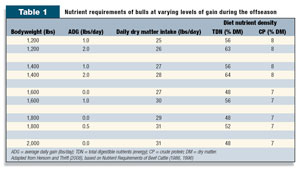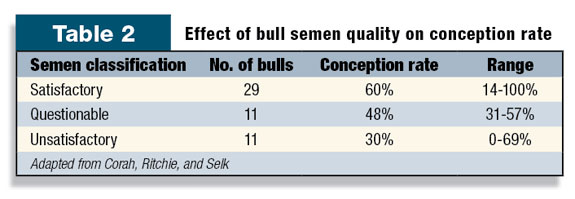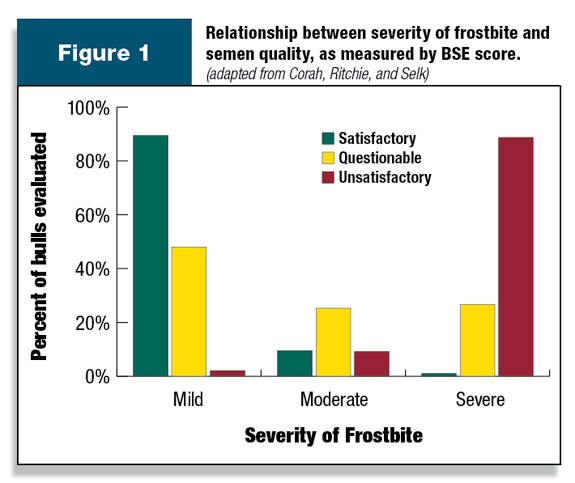It’s easy for cow-calf producers to put their bulls on the “back burner” during winter, especially with so much time spent catching up on other projects. Unfortunately, this causes many bulls to be nutritionally forgotten, leading to potential problems the following year.
At a time when hay prices are high, and trending upward, it’s also possible some producers might inadvertently underfeed their bulls in order to save money. Proper nutritional management of bulls during winter is crucial to ensure success during next year’s breeding season. This is particularly true for thin and/or young bulls that just completed their first breeding season last summer.
First, check your ‘battery’
Some folks chuckle when they hear the words “bull battery” in reference to the bulls they use on their cowherd. But it’s a great way to characterize how important your bulls really are to the success of your operation. Bulls are used on a cow-calf operation for one reason – to serve as multiple pieces of “artillery” and work together to get your cows pregnant early in the breeding season.
Everyone knows bulls provide half of the genetics in a calf crop. However, bull fertility far outweighs cow fertility, at least if you consider the number of cows a bull should breed during a season (e.g. 25 to 40). With over 90 percent of U.S. operations using only natural service to get cows pregnant (based on USDA survey data), just one poor-performing or infertile bull could cause a lot of open or late-bred cows on nearly any operation.
Getting cows to conceive early in the breeding season is crucial to the long-term reproductive and financial success of an operation. Otherwise, an increase in open and late-bred cows this year will result in a longer calving season next year along with calves that are younger, lighter-weight and worth less money.
Among spring-calving operations, most bulls are removed from the cowherd at the end of the summer. It’s important these bulls be given a period of post-breeding season “R&R” (rest and recuperation), particularly since it is not uncommon for bulls to lose 10 to 20 percent of their bodyweight during a single breeding season.
Each bull in your bull battery should be evaluated annually for his health and ability to breed, including structural soundness and vigor. After culls are removed, bulls should be divided and fed in two groups:
- Older and more dominant bulls that have decent body condition
- Younger and thinner bulls
It is important to separate bulls, since these two groups have significantly different nutritional needs.

Meet winter nutritional needs
Most mature bulls in good body condition can get by on a 100 percent forage diet, without supplementation. For instance, a hay diet consisting of 7 percent CP (crude protein) and 50 percent TDN (total digestible nutrients, a measure of energy) will meet a mature bull’s requirements, but only if he doesn’t need to gain weight. A daily feed intake equivalent to about 1.5 to 2.0 percent of bodyweight should be targeted, and body condition should be monitored closely.
In contrast, young bulls that lost significant weight during the previous breeding season (and are still growing) usually need to gain upwards of 1 to 2 pounds per day during the off-season. Older and bigger bulls that are thin may only need to gain about 0.5 to 1.0 pound per day. Nutrient requirements for growing, thin, and mature bulls at varying levels of gain are included in Table 1.
Based on Table 1, “high risk” bulls (young and/or thin) need a forage diet that is about 2 percent of their bodyweight (1,400 pounds × 2 percent = 28 pounds per day) and enough supplement to make the total diet consist of about 7.5 to 9.0 percent CP and 55 to 65 percent TDN. Typically, about 5 pounds of most grain products will help to meet this requirement. Ultimately, proper winter nutrition will enable a producer to turn-out young bulls at the start of the breeding season with an ideal body condition score of 5.5 to 6.5.

Prepare bulls early
Even though your bulls may try to convince you they are still on vacation during springtime, it’s important to spend time during the spring to get them ready for the breeding season – especially after feeding them all winter. Bull fertility is generally affected by four variables:
- Testicle size (scrotal circumference)
- Semen quality
- Libido (generally not directly measured in the U.S.)
- Structural soundness
The most crucial thing you can do for your bull battery’s fertility is to evaluate semen quality on every bull about 30 to 60 days before breeding season starts with a breeding soundness exam (BSE). This evaluation of their reproductive capacity (via measurement of scrotal circumference and collection and analysis of a semen sample) helps to eliminate bulls unable to do their job.
Numerous trials and datasets have proven the value of a BSE, including data from the late Dr. Jim Wiltbank, where semen classifications were compared to subsequent conception rates (Table 2).
Interestingly, results of a USDA survey indicate that 57 percent of operations had a BSE conducted on newly introduced bulls. However, only 17 percent of cow-calf operations had a BSE done on bulls already on their operation (i.e. not purchased recently). Larger herds were more likely to have a BSE done (54 percent) than small herds (11 percent). This is a great opportunity for producers to easily identify subfertile or infertile bulls.
Beyond conducting a BSE, it is important to annually process bulls in order to vaccinate, control insects (particularly lice and flies), test for trichomoniasis (particularly in states with regular outbreaks and/or if your cows and bulls are mixed with another owner’s cows and bulls), and check feet and legs prior to turn-out. It is also important to plan ahead so bulls expected to share a breeding pasture during the breeding season can be grouped together in advance.

Avoid lazy, injured or frostbitten bulls
Unfortunately, in the wintertime some bulls get demoted to the poorest facilities on an operation. Yet, the design and layout of a bull pen can be critical for several reasons. Some publications have suggested that bull wintering facilities provide up to 2 acres per bull, especially if fighting is common. This may seem excessive, but an effort should be made to promote activity by bulls. This can also be done by putting substantial distance between feeders/bunks (if used), waterers and loafing areas. If bunks are used, plenty of room (at least 2 feet per bull) should be provided.
Protection from severe winter weather (particularly wind chill) should also be made available to bulls. Extreme cold weather can freeze the lower part of the scrotum, leading to permanent damage and a reduction in semen quality. The relationship documented between BSE score and severity of frostbite in bulls indicates how seriously frostbite can affect fertility (see Figure 1). For instance, the percentage of bulls with an “Unsatisfactory” BSE score increased from 1 percent (with mild frostbite) to 27 percent when frostbite was considered moderate. Further, 89 percent of bulls had an Unsatisfactory BSE score when frostbite was severe.
Tissue damage due to frostbite appears as discoloration, scabbing, and/or sloughing of the lower portion of the scrotum. Frostbite can be prevented by providing a shelter, windbreak, or heavy bedding (e.g. straw) for bulls to burrow into.
Summary
Nutritional management of bulls is critical, particularly during times of high feed costs and high replacement bull prices. Plus, a bull’s fertility far outweighs that of any single cow. One bull that is unable to breed due to soundness, body condition or fertility problems can cause many open or late-bred cows and cut into a producer’s bottom line. ![]()
Author’s note: Additional information on the nutritional management of beef bulls is available via two fact sheets available online: “Nutritional management of bulls” by Hersom and Thrift (http://edis.ifas.ufl.edu) and “The reproductive and nutritional management of beef bulls” by Corah, Ritchie, and Selk (http://www.iowabeefcenter.org)
PHOTO
TOP: Bulls like these at the Van Newkirk Hereford Ranch in Nebraska need protection from severe winter weather, when frostbite grows more common. Photo courtesy Cindy Van Newkirk.

Jason K. Ahola
Associate Professor
Beef Production Systems
Colorado State University
Jason.Ahola@colostate.edu







